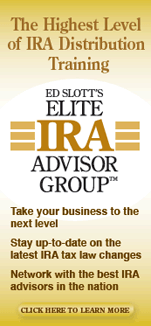
- Ed as a Speaker
- Ed Slott's IRA Advisor Newsletter
- Shopping Cart
- Discussion Forum
- IRA Resources
- IRA and Tax Tables
Assistance
15 ROTH IRA CONVERSION TRAPS
|
The Roth conversion floodgates have opened. In order to take advantage of this golden opportunity you need to avoid the pitfalls and have the necessary information that other financial advisors don't know to ask about. We know the importance of this subject, so we devoted February's edition of Ed Slott's IRA Advisor Newsletter to 15 Roth IRA Conversion Traps. Also, an entire 1-Hour Webcast, 15 Roth IRA Conversion Traps, is available on our website RIGHT NOW through February 26th. |

|
Inside Ed Slott's IRA Advisor Newsletter15 Roth Conversion Traps
- The Roth Recharacterization Fix If you are not already an Ed Slott IRA Advisor Newsletter subscriber, you can preview past issues before subscribing. |
|

Q: Can a 50-year-old who has been in a 72(t) for 18 months do a partial conversion to a Roth? Could he or she return all funds to an IRA and "erase" the effects of the 72(t) then do a conversion? A: If you are taking payments under the 72(t) exemption you can convert all of your traditional IRA to a Roth IRA. There is no consensus as to whether you can do a partial conversion. You will have to continue to take the full 72(t) payments on the account after the conversion. You can not erase the effects of the 72(t) payments when you do a conversion to a Roth IRA. Any 72(t) payments from the Roth will be income tax free because you would have paid the income tax due when you converted. |
||
|
|||







